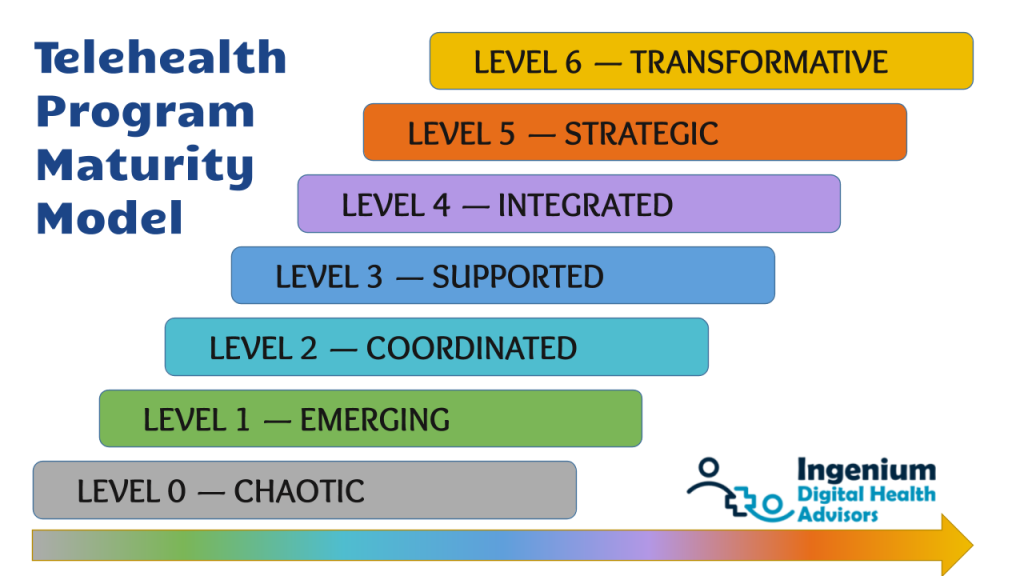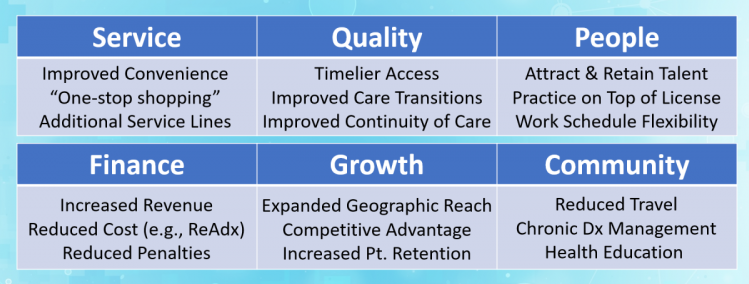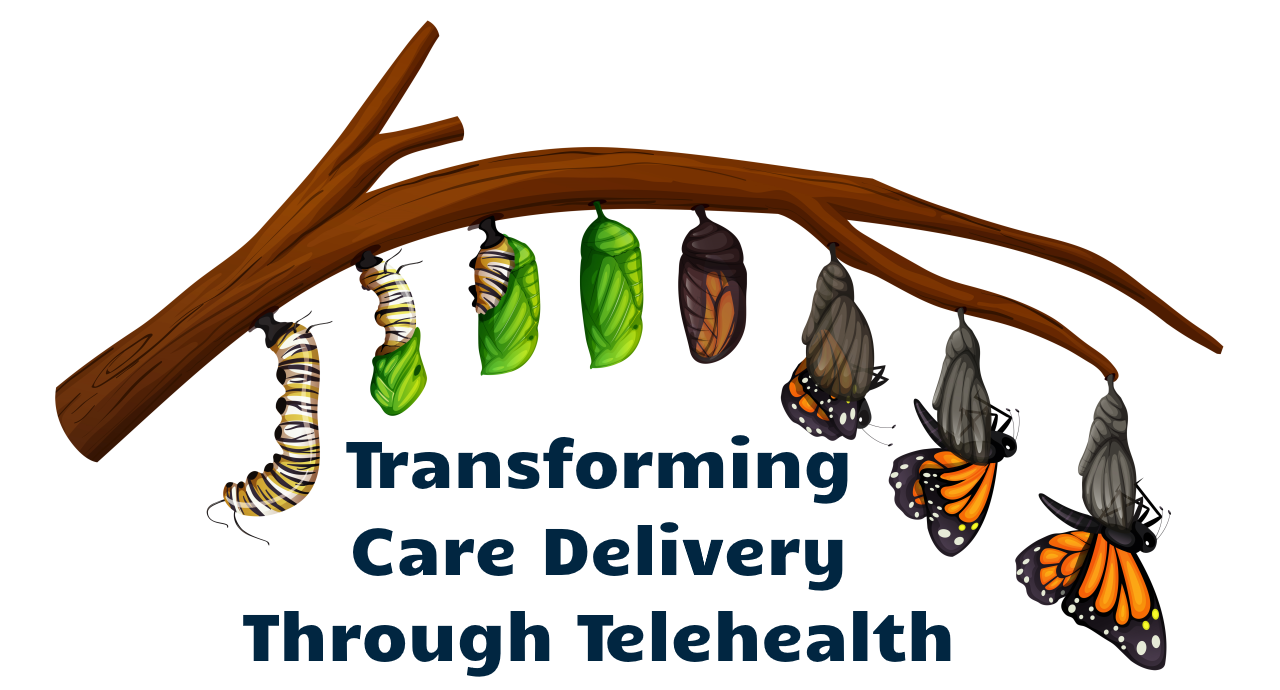A few weeks back I posted a couple of articles describing the 7 levels of telehealth maturity that organizations pass through as the acceptance and permanence of their telehealth services grows.
Most organizations, especially during the start of the Covid-19 health crisis start out at the “Chaotic” or “Emerging” maturity level to quickly move toward the more desirable maturity levels of “Coordinated” or “Supported” (a full description of these four levels can be found in the article describing how to grow telehealth maturity from “Chaotic” to “Supported”.



The Higher Stages of Maturity
As with the human experience, telehealth programs undergo their own life cycle as the maturity of the telehealth services and the telehealth program grows. The three stages that follow are: Integrated, Strategic and Transformative. Here are their definitions again:
Level 4 — Integrated: Once a centralized support team with best practices can manage the proper launch of new services, telehealth can quickly spread across all specialties and all modalities – whether to offer patients access to specialty care or integrating remote patient monitoring services. From a patient’s perspective, receiving care online across a spectrum of services is seamless. Finally, clinical data generated during telehealth visits or remotely collected is available for clinical decision making in the patient’s medical record.
Level 5 — Strategic: At the strategic level, organizations are fully leveraging telehealth by proactively using the launch of new telehealth services and the expansion of existing services to drive the fulfillment of their overall organizational strategic objectives. Engaging with patients at a distance and in person is the organization’s “new normal”.
Level 6 — Transformative: At the top maturity level, healthcare organizations are redefining care delivery by creating innovative care delivery models including virtual hospitals. Where necessary, transformative organizations design and develop their own telehealth solutions to meet their innovative needs. The organization is on a continuous pursuit of constantly reviewing and improving its telehealth capabilities and moving towards enabling “Empowered Wellness” for its patients by truly delivering connected care.
From Supported to Integrated
While “skipping levels” or accelerated progression through each level is possible in the lower levels of maturity, to reach Level 4, “Integrated”, the organization must invest in reaching Level 3, “Supported” first. This entails at a minimum the assignment of a dedicated resources to manage the ongoing operations of supporting telehealth services throughout the organization, including an administrative and a medical telehealth director, a telehealth coordinator and a technical telehealth support person.
From this base level of maturity, the organization can now — with the use of a repeatable and scalable methodology to support the optimization, growth, expansion and launch of telehealth services — start to roll out and grow/expand telehealth services in all areas of the organization that have an interest. At this maturity level it is still very much a “pull effort”, i.e., various clinical stakeholders develop a strong interest in leveraging telehealth in their practice and ask for a technical solution and support.
Once telehealth has been established across multiple service lines as a viable alternative to the traditional in-person and outpatient care delivery models, it can be thought of as having reached “Level 4 — Integrated”.
From Integrated to Strategic
One of the biggest shifts in how Telehealth is perceived and treated occurs when the momentum of telehealth fully reaches the consciousness of the senior leadership team. Whereas Telehealth may have previously shown up as a singular strategic objective, once an organization reaches “Level 5 — Strategic”, telehealth is no longer seen as a separate “project” but a strategic tool, that can advance virtually ALL strategic objectives (no pun intended).
Just look at this quick brainstorm on how telehealth can help achieve the organizational strategic objectives across the typical six pillars of a healthcare organization’s strategic plan:



At this maturity level, telehealth is no longer merely a way to deliver care, but is proactively used as a strategic tool. See “Telehealth Creates Strategic Success” for more information.
Leveraging Telehealth to Transform Care Delivery



Especially organizations, like the Mayo Clinic, that truly and consistently put the needs of the patients first, will no longer ask the question “how can telehealth help us to achieve our objectives” but rather ask the more revolutionary question of: “How can we leverage telehealth solutions to deliver extraordinary care?”. How can we take full advantage of technology and innovation to not only enable our clinicians to practice on top of their license, but to put the needs and desires of our patients first?
That’s when organizations truly complete their journey: by fully embracing and embedding “care at a distance” solutions to focus on excellent outcomes at a lower cost with higher satisfaction for clinicians and patients alike.
That’s telehealth at its finest.
Are we There Yet?
So is this state, this level an illusionary pipedream? I don’t think so.
For years, I’ve seen promising beginnings of a transition to “Transformative” in numerous well-run telehealth programs. E.g., the way that Lehigh Valley and Jefferson Health (both in Pennsylvania) or Intermountain Health are reimagining their organizations’ care delivery services is an example of how to tap into the Transformative potential of telehealth.
To move through the various maturity levels, it does not matter if you are a small specialty practice, an urgent care center, a behavioral health clinic or a fully integrated service delivery network. The model works well for all sizes of organizations, just that smaller organizations can get there in a matter of months, not years.
So, where do you think your organization’s maturity level is at? Drop me a note or set up a call to discuss.








To receive articles like these in your Inbox every week, you can subscribe to Christian’s Telehealth Tuesday Newsletter.
Christian Milaster and his team optimize Telehealth Services for health systems and physician practices. Christian is the Founder and President of Ingenium Digital Health Advisors where he and his expert consortium partner with healthcare leaders to enable the delivery of extraordinary care.
Contact Christian by phone or text at 657-464-3648, via email, or video chat.







Leave A Comment